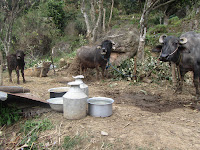 Fun with a few Irish people in Celtic Pub on St Pat's Day here in Kathmandu
Fun with a few Irish people in Celtic Pub on St Pat's Day here in Kathmandu





OBSERVATIONS OF NEPALESE WAYS
While in Pokhara the balcony of my room was overlooking a tiny Nepalese household, at least it looked tiny consisting of a very small hut and two sheds. One of them may have been the toilet.
I was awakened every morning around 6 am by the sound of the woman of the house already splitting wood for the little fire that she started. Like all Nepali she could squat down for hours while working, blowing on the fire to get it going, inserting long pieces of wood to lift her pot up when it was boiling too much etc. She carried out about six pots, lids and ladles and started pounding with a brick on whatever she was preparing to cook. Somehow she prepared food in all six pots although she had to keep rotating them since she had only one fire.
Gradually more women would arrive and some had small children while school children in their uniforms would get their plates filled and they would squat down to eat a full plateful before going to school. A few men would drift over too and all would eat from the never ending food in the pots – where did they all sleep? In that one room? Washing themselves seemed to be from a big barrel in the yard that held water possibly since the last monsoon. That garden is in picture one.
After the meal big basins were filled with the clothes that needed to be washed and this was again done squatting. What a huge amount of labour and time has to be put in to this way of living although I only saw everyone wearing the same clothes the whole week so I suppose the washing is not too much. Despite the time needed for the necessities of life most people seem to spend hours just sitting or squatting in the open. There one can get the rays of the sun and the light which is scant indoors in their tiny dark room mainly having only 4 hours of electricity in the day and the rest during sleeping hours.
The children here are great. They wear spotless uniforms to school and all ages, from tiny to adult, go around with their arms around each other or holding hands. They laugh a lot and sing to themselves. Even tiny children, with their parents, will smile when they meet a foreigner. The main impression I have of the Nepali people is of their kindness and courtesy





Pokhara is like an oasis in the dessert after one has been in
I stayed downtown for a few days before going up a mountain halfway to a lovely hideaway called the Castle. It is owned by an Irishman Joe and a lovely Portugese lady Sofie who rightly describe it as a paradise. There s perfect little rooms in the round, a swimming pool, a bar named Brannigans, really good food and wonderful views. There’s little to do except roam the hills around and maybe meet a few monkeys and certainly some farmers and buffalo, hens and goats.



CHANGU NARAYAN
This ancient temple is not far from Bhaktapur. The courtyard there has wonderful statues of Vishnu and Garud The roof supports are all carved and painted in intricate designs. There were school children there on an outing and I was soon surrounded as they all like to have their pictures taken with a foreigner and I’m very popular since I have white hair, not seen so often here. Children here are so very nice. They are shy and always smile in passing but they are brave enough to greet and try to converse in English. Even their teachers want to spend time talking with interest
I started off to find this old, famous, Buddhist site, one of the 3 most revered religious pilgrimage sites south of the

BHAKTAPUR,
Bhaktapur is a UNESCO World Heritage ancient Newari city, it is free of the beeping horns and traffic of
In the squares there are old pumps where the women still wash themselves and their clothes while others squat down to try to sell their wares of vegetables and fruit out of their baskets that they carry on their heads while walking.
